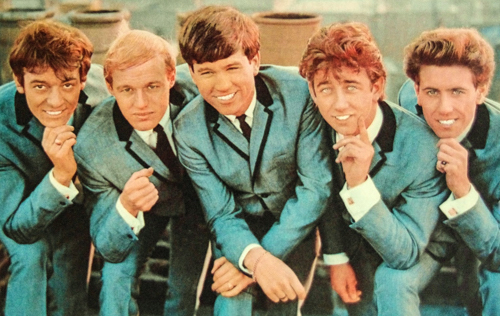BY JIM MELLOAN | This month marks the 50-year anniversary of the debut of The Hollies on the Billboard Top 40. “Look Through Any Window,” penned by the prolific young songwriter Graham Gouldman, later of 10cc, peaked at No. 32 on the January 22, 1966 chart. I was 10, and, as far as I recall, unaware of The Hollies. But when my family moved to London in November of 1966, the band’s glorious three-part harmonies and catchy melodies suffused the airwaves.

Thanks to the BBC TV show “Top of the Pops” and DJ Alan Freeman’s BBC radio show “Pick of the Pops,” I became a committed chart-tracker. And in the spring of 1967 I walked down to Harrods, near our house, went up to the fourth-floor record department, selected The Hollies’ “Carrie Anne” out of the giant slots that held each of the current hit singles in order of chart rank, and paid my 10 shillings — my first-ever record purchase. (Later that year, on that floor, Harrods debuted the ultra-groovy Carnaby-Streetesque “Way In” store-within-a-store.)
The core of the group, Allan Clarke and Graham Nash, were friends since age five in Manchester. Like the Beatles and many bands of the time, they got started as part of the skiffle craze of the late ’50s. They came up with their name in December of 1962 as both a tribute to Buddy Holly and a nod to the season. After an appearance at Liverpool’s famed Cavern Club in January of 1963, they got an audition for a record contract, which they won. Band member Vic Steele played guitar at the Cavern Club gig, but he didn’t want to be a professional musician — so Tony Hicks replaced Steele for the audition, then assumed his place in the group.
By the time “Look Through Any Window” was released, the band had had quite a few hits, both covers and originals, on the UK charts. Their follow-up to that one was a bit of a misfire: they recorded George Harrison’s “If I Needed Someone” and released it as a single, learning just days later that the Beatles were including the song on their “Rubber Soul” album. (But what a great version; I didn’t know about it until I started researching this article.) The single went to No. 20 on the UK chart, but wasn’t released here. The Hollies finally made their name in the US with “Bus Stop” — another Gouldman composition, which peaked at No. 5 both there and here.
At the time we moved to London, “Stop Stop Stop” (a Clarke-Nash-Hicks tune notable for its banjo part) was climbing the charts. I don’t really remember that one from the time, but I definitely recall “On a Carousel,” by the same three, from February of ’67.
It was “Carrie Anne” that I found irresistible, however. That one came with springtime lunch hours in Regent’s Park, near where I was enrolled at the American School in London (ASL). Coming close after the Beatles’ “Penny Lane,” both sunny and infectious songs epitomized the glory that was Swinging London in 1967. My mom purchased “Penny Lane/Strawberry Fields Forever,” and I decided it was my duty as a budding music consumer to buy “Carrie Anne” on my own.
“Carrie Anne” was the first commercial song ever to incorporate steel drums. I recall one clueless reviewer at the time praising The Hollies for their innovative use of a “toy piano.” In 1995 Nash revealed that the song was actually inspired by Marianne Faithfull, who Nash had a crush on, but who was having an affair with the married Clarke at the time.
In the fall of ’67 The Hollies released “King Midas in Reverse,” a lush, ambitious song written solely by Nash. I have a memory of hearing that one, or thinking about it, in the lunchroom at ASL, amidst the junior high bustle and steaming cups of hot soup in yellow plastic cups served by Cockney lunch ladies. I don’t know if I reflected upon the fact that the lyrics mirrored my own plummeting social status — but they did. This one only went to No. 18, a relative disappointment, and that was the beginning of the end of Nash’s time with The Hollies.
After that one, he and Clarke wrote “Jennifer Eccles,” a catchy piece of fluff that returned The Hollies to the UK Top 10. By now, though, Nash had broader ambitions. He had written “Marrakesh Express,” but he’s said that The Hollies didn’t seem very interested in working on it. He had been spending more time in the US, and had met David Crosby and Stephen Stills, and so decamped to form Crosby, Stills & Nash and move on to the next part of his career.
The Hollies had a big hit in 1969 with with “He Ain’t Heavy, He’s My Brother,” a ballad that was a departure from their poppy harmonies, and their other notable successes in the ’70s were the rocker “Long Cool Woman in a Black Dress” and “The Air That I Breathe” It was their version of Springsteen’s “4th of July, Asbury Park (Sandy),” retitled as just “Sandy,” that got me working on performing that one around 10 years ago.
Clarke retired in 2000, but Tony Hicks is still with the band, and they will commence touring the UK and Europe in March.
Happy anniversary, boys.

















